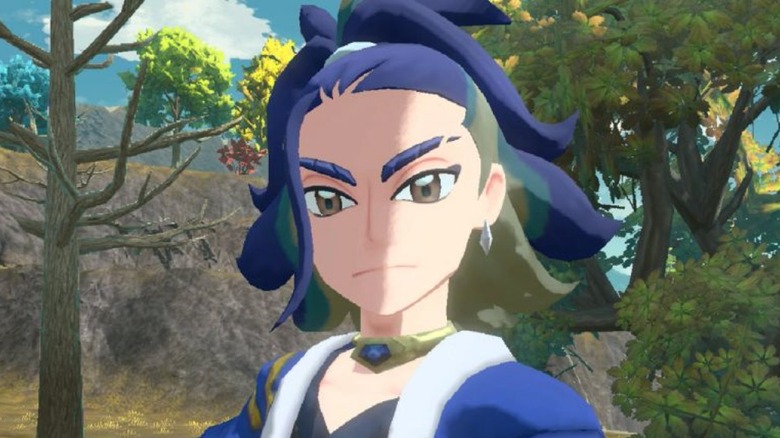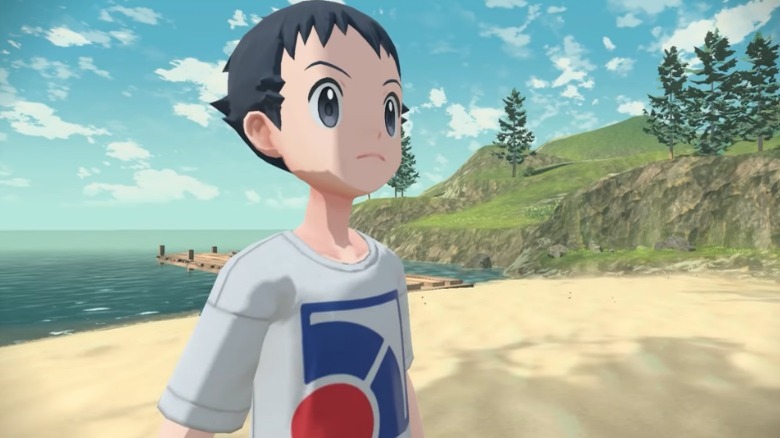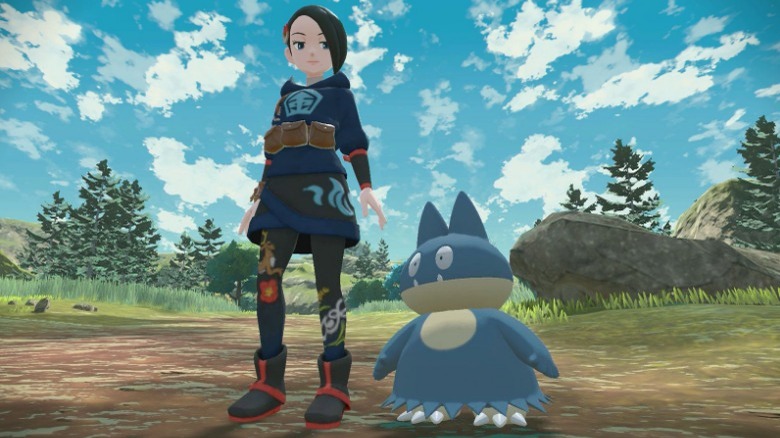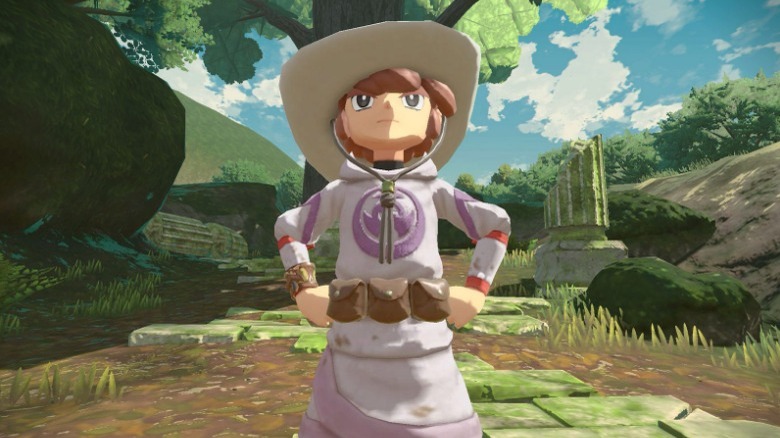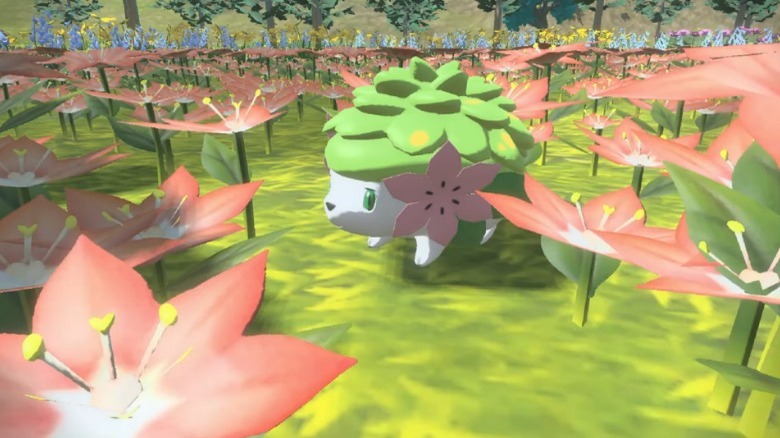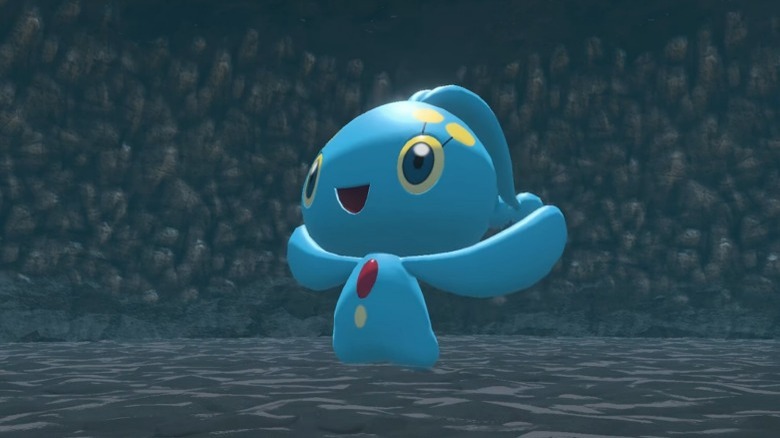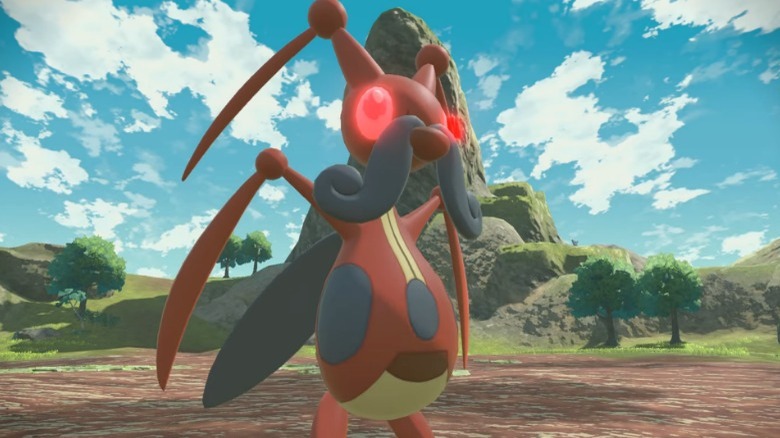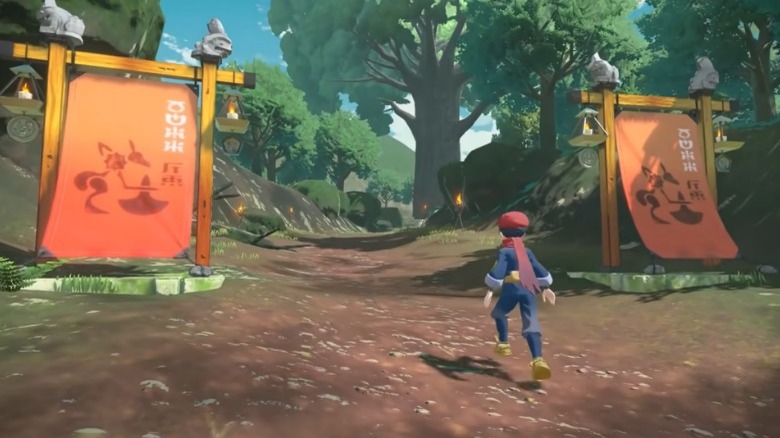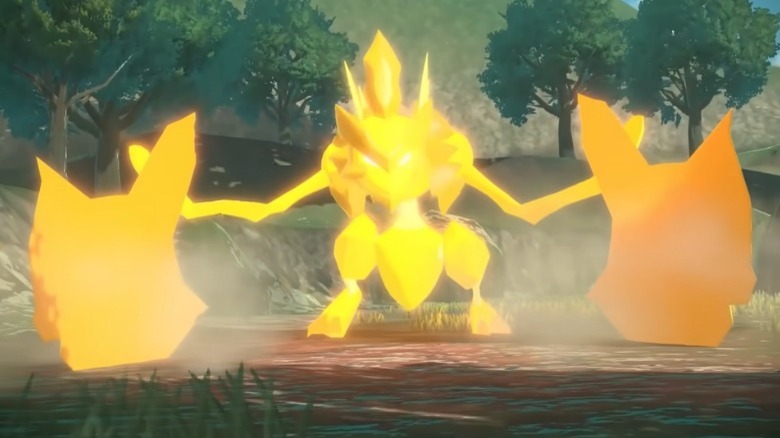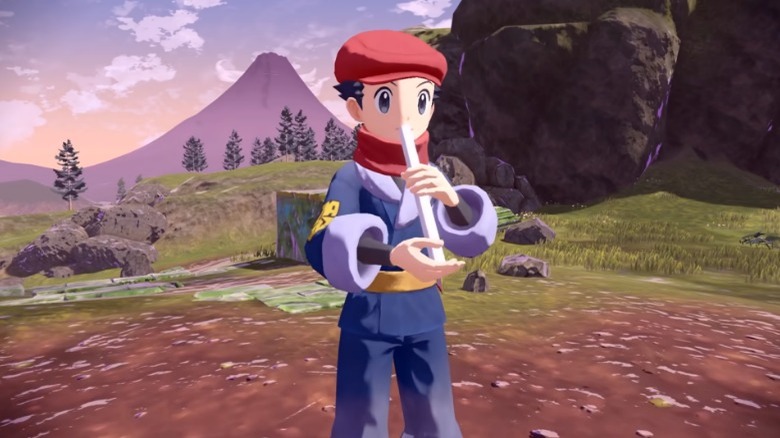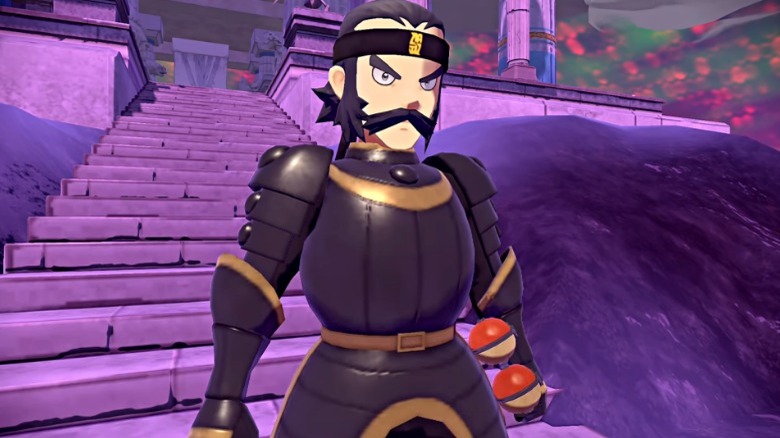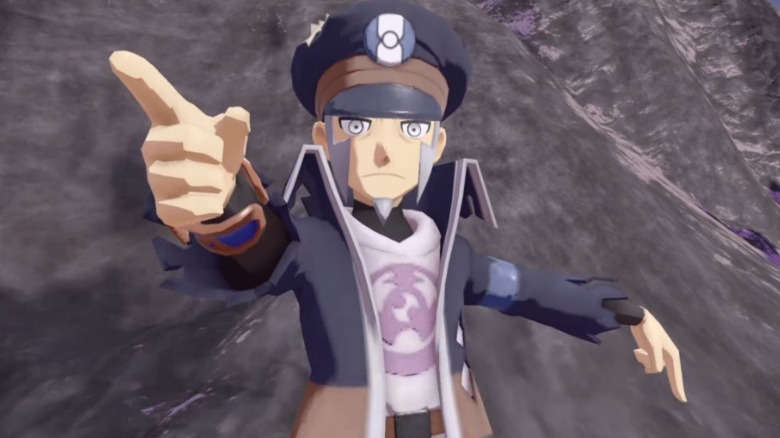Easter Eggs You Missed In Pokemon Legends: Arceus
The "Pokemon" franchise has a long-standing tradition of inserting Easter eggs into its games. These can even include references that cross the borders between video game franchises. "Pokemon Legends: Arceus" continues this proud gaming custom, cramming in a variety of references to other games.
The land of Hisui is bigger and more explorable than any other region in "Pokemon," even though it is just an ancient and untamed version of Sinnoh. The developers understandably had more space to lay their Easter eggs. But, since Jubilife Village is the only major dot of civilization in the game world, the development team had to get more clever about where and how they hid references. Some might go over many players' heads, but we're here to help guide you through some of the game's most mind-blowing hidden moments. Here are the biggest Easter eggs we found so far.
Be warned: Some of these entries contain spoilers.
Where Have We Seen Those Clothes Before?
When Nintendo announced "Pokemon Legends: Arceus" would be the franchise's first entry chronologically, audiences assumed every character would hail from that ancient time period. That prediction didn't pan out, as the game opens with the main character being ripped out of time and space — and it wasn't the first instance where that's happened in the "Pokemon" franchise, mind you. However, since the protagonist hails from the future, they get to serve as one of the game's first Easter eggs.
Since the main character didn't expect to be pulled into pre-industrial Sinnoh, they didn't get a chance to dress properly. When the game starts, the protagonist only has the clothes on their backs, as well as an Arceus-powered smartphone. But, the clothes are the Easter egg here since they are ripped straight from previous "Pokemon" games. Anyone who makes their character a boy starts with the white logo t-shirt from "Pokemon X" and "Y," and players who pick a girl begin with the luxury holiday loose top from "Pokemon Sword" and "Shield." Thankfully, players acquire more time/climate-appropriate attire within a day.
On the surface, the clothes merely reference older "Pokemon" games, which is always welcome, but what if they mean something more? Could the clothes indicate that the male character hails from Kalos while the female character is a native Galarian? Regardless, it's still a cute reference for longtime fans.
The Hisui People Have Strong Genetics
Odds are you've seen pictures of your grandparents and noticed that, in their prime, they looked remarkably like your parents. That's just how DNA works. But, how far back do you have to rummage through your family tree before ancestors lose all resemblance to modern family members? In the world of "Pokemon," pretty far.
Since "Pokemon Legends: Arceus" takes place in the past, the developers apparently decided to reference previous games by populating Hisui with the ancestors of Gym Leaders, Trainers, and other prominent characters. Almost every NPC in "Legends: Arceus" resembles their far-flung family. For instance, Cyllene's blue hair and sharp features indicate a clear lineage with Team Galactic Boss Cyrus. Meanwhile, Volo shares Pokemon Champion Cynthia's face and hair, and to solidify the connection, Volo's battle theme combines Cynthia's encounter and battle themes to an intimidating degree. But, some of the most surprising ancestry Easter eggs crop up in characters who don't physically appear.
Players who visit the Diamond and Pearl Clan camps will find three interesting paintings, two in each camp. The left painting in each tent is the same and bears a striking resemblance to Pokemon Champion Alder from "Black" and "White," while the right paintings are different. In the Diamond camp, the right painting is of a stern, red-haired man who looks virtually identical to Team Magma Leader Maxie, while the Pearl camp's painting parallels Team Aqua Leader Archie to a frightening degree. And, the paintings of not-Maxie and not-Archie are adorned with symbols that resemble the logos of Team Magma and Team Aqua, respectively.
Not only do these Easter eggs honor the legacy of "Pokemon," but they also imply that future "Pokemon Legends" sequels might sport even more ancestors of prominent franchise characters and villains.
The Diamond and Pearl Clans Are Based on the Ainu
It's no secret the "Pokemon" franchise draws inspiration from the real world. More recent regions, such as Kalos and Galar, take cues from France and the UK, respectively, but earlier entries and their regions were based on Japanese geography. For instance, Sinnoh is based on Hokkaido, and since "Pokemon Legends: Arceus" takes place in ancient times-Sinnoh, the game fittingly draws from Hokkaido's pre-modern Japan, specifically its original inhabitants.
In "Pokemon Legends: Arceus," Jubilife Village is the only sign of "modern" civilization in Hisui. The rest of the game world is covered in untamed wilderness and mysterious, ancient ruins. The only exceptions are the Diamond and Pearl Clans, who predate Jubilife, and their camps. These clans aren't so much an Easter egg as they are a reference to the real-life Ainu people.
Long ago, possibly as far back as prehistoric times, the Ainu were the sole inhabitants of Hokkaido, which mirrors the whole "Diamond and Pearl Clans living in a land based on Hokkaido" thing. The Ainu relied on the Yezo sika deer for food and clothing, and the Diamond and Pearl Clans revere Wyrdeer, an evolution of Stantler supposedly based on the sika deer, and use its fur to make warm winter clothes. Coincidence or intentional reference? How about the new Ursaring evolution, Ursaluna? Not only is it a bear, but its new Ground typing and mountain-like body link it to the Ainu god of mountains and bears, Kim-un-kamuy.
Maybe we're reading into things too much, but the Diamond and Pearl Clans and several Hisuian Pokemon share too many connections to the Ainu to be a coincidence.
Floaroma Town used to be Floaro Gardens...Probably
Since "Pokemon Legends: Arceus" takes place in Sinnoh before it became known as such, the game doesn't have much in the way of recognizable landmarks. Jubilife Village is obviously supposed to be Jubilife City in its early days, while Mount Coronet is virtually unchanged (because it's a mountain). You'd be hard-pressed to link all the areas of Hisui to their Sinnoh counterparts, except for, one thanks to an Easter egg.
In the northwest portion of the Obsidian Fieldlands, players can find a brown patch of withered flowers ironically called Floaro Gardens. Maybe players discover it on their own, or maybe they find it during the request "A Token of Gratitude” (which only unlocks if a save file for "Pokemon Sword" or "Shield" is on the Switch). Either way, Shaymin will make the brown patch bloom with flowers during the request. This event should sound familiar to anyone who played "Diamond" and "Pearl" or their remakes.
In "modern day" Sinnoh, players can visit Floaroma Town, which was once supposed to be a barren hill where nothing grew. According to the town's legend, people kept planting flowers regardless, which all withered and died. Then one day, someone offered thanks, and as the story goes, Shaymin made the flowers bloom in response. This tale lines up almost perfectly with what players witness in "Pokemon Legends: Arceus," from the blasted patch of land where nothing grows to Shaymin causing the sudden germination.
To be fair, Floaro Gardens isn't much of a hill, but hey, sometimes stories are misremembered. If we can't even get lines from old movies right, then it's a miracle anyone can remember the origins of Floaroma Town with any accuracy.
A Self-Fulfilling Easter Egg
Nintendo might have announced "Pokemon Legends: Arceus" alongside "Pokemon Brilliant Diamond" and "Shining Pearl," but the latter ultimately beat "Legends: Arceus" to store shelves. While "Brilliant Diamond" and "Shining Pearl" were seemingly straight-up remakes, gamers still scoured the games for anything new. Their searches came up almost empty except for a few tiny changes, including one addition that would be paid forward in "Legends: Arceus."
If players visit the Canalave City library in "Brilliant Diamond" and "Shining Pearl," they can find a new book that tells the tale of a human who sought out a Pokemon "prince" with the help of a Mantyke, a Buizel, and "a Qwilfish with huge spikes." This story does absolutely nothing in the game, but "Pokemon Legends: Arceus" owners can reenact it — or possibly serve as its main characters.
In "Legends: Arceus," players can accept the quest "The Sea's Legend," which is not so coincidentally the story's title. Completing the request is as easy as catching a Mantyke, a Buizel, and a Qwilfish with huge spikes, which is to say it's not easy at all since the story actually refers to Qwilfish's evolution, Overqwil, and players need to use the Strong Style of Barb Barrage 20 times to make Qwilfish evolve. When those Pokemon are in the player's party, all one has to do is sail through the two pillars in the Cobalt Coastlands during the evening, and the game will spawn a Manaphy and several Phionne, ripe for catching. Why Manaphy? Because in one of the "Pokemon" movies, Manaphy is called "the Prince of the Sea."
The Onomatopoeia of Kricketune
The "Pokemon" series has a complicated relationship with the sounds of its title creatures. In the games, Pokemon cries are a mix of bleeps, bloops, and the occasional fart, but how do you translate those sounds into words? The anime showrunners decided to invent their own Pokemon voices (i.e., make every Pokemon scream its name), while the game developers do their best to provide onomatopoeia. Some Pokemon cries are easier to translate than others.
When "Pokemon Diamond" and "Pearl" premiered on the Nintendo DS, developers used the handheld's improved audio hardware to invent Pokemon cries that surpassed previous games. Kricketune is the face of this advancement, as the creature sounds (and looks like) a living violin. Audiences struggled to translate this crazy cry into words but eventually settled on "Delele whoooooooop." The idea eventually became a meme but remained unofficial as Game Freak never interpreted Kricketune's cry until "Pokemon Legends: Arceus."Early in "Legends: Arceus," players will get their first taste of an Alpha Pokemon either by encountering a giant Rapidash or, more likely, an Alpha Kricketune. While the Rapidash is more powerful, the game gives the Kricketune its own cutscene and mission. More importantly, the Alpha Kricketune's cry is transliterated as "De-le-le woooooop," which is identical to the fanmade onomatopoeia but with some hyphens and minus the "h."
Either the team behind "Pokemon Legends: Arceus" wanted to reference the meme and make it canon, or they came up with the same translation all on their own. Regardless, it's good to see developers and fans dancing to the same tune.
The Noble Pokemon Flag Toppers Look Familiar
The "Pokemon" franchise has probably gone through more creature concepts than any other game in existence simply by virtue of its roster of almost 900 catchable monsters. While many initial designs were eventually refined into the Pokemon we know and love, others were scrapped. One design might have been turned into both a Pokemon and a recurring motif that also appears in "Pokemon Legends: Arceus."
Throughout Hisui, players can find little statues of a squat, unidentified Pokemon. The statue almost looks like a Gible, except the head fin is the wrong shape, and it has back nubs instead of Gible's weird jet engine horns. These statues also adorn the flags that denote a Noble Pokemon's territory and most likely reference the classic Gym statues. After all, Noble Pokemon are the closest we get to Gym Leaders in "Pokemon Legends: Arceus."
Alternatively, the statues could be a reference to the Substitute doll, which sports the same squat body and back nubs, albeit with two small horns instead of a large head fin. Moreover, both the doll and Gym statues appear to be based on the beta Rhydon design. Not only is Rhydon the first Pokemon ever created, but before Generation 3, the Substitute doll was a plush Rhydon. Coincidence or an intentional way to keep an early design alive?
Kleavor Is a Play on a Japanese Nickname
The "Pokemon" franchise relies on wordplay. Most creature names are portmanteaus and puns of different words and are usually translated accordingly. For instance, Scizor is a corruption of scissors, but its original Japanese name, Hassam, is likely a corruption of hassamu, which means "to snip." However, some Pokemon don't just rely on wordplay for their names; some rely on wordplay for their physical designs.
While players can evolve Scyther into Scizor in "Pokemon Legends: Arceus," the praying mantis-like Pokemon can also evolve into the Kleavor, which trades its hand sickles for hefty obsidian axes. The name is, like Scizor before it, a corruption of a word, specifically "cleaver." Plus, Kleavor likes to cleave trees and prey in two, which makes it a literal cleaver, but the monster's design likely originates from an old Japanese nickname.
While the Japanese word for praying mantis is kamakiri, the insect is also occasionally called onomushi, which translates into "axe bug." Since Kleavor retains Scyther's mantis-like design but has giant axes, it is a literal axe bug. A little on the nose, but then again, Charmander's Japanese name is hitokage, which is also Japanese for "salamander." Sometimes, efficacy wins over subtlety.
To be fair, every Pokemon's name needs to relate back to its physical design, but Kleavor provides a bit more insight into Japanese etymology than other Pokemon. You can't ask for a better Easter egg than one that helps you appreciate another culture.
A Familiar Flute
Players have many ways to get around the world of "Pokemon." In the past, gamers only had their own two feet, a bike, and whatever Pokemon they owned — some of which players only kept for utility purposes, not battling. Game Freak has experimented with alternatives, which usually results in rideable Pokemon. Since "Pokemon Legends: Arceus" chronologically predates the invention of bicycles, players rely on foot power and Pokemounts, but how to summon the rideable creatures? With an Easter egg, of course.
When players are introduced to Wyrdeer and allowed to ride it, the game plays a cutscene where Mai demonstrates how to call Wyrdeer. The task consists of playing several notes in quick succession on a flute — four extremely familiar notes. Eagle-eared gamers who have played "Diamond" and "Pearl," as well as their remakes, should recognize the notes from the games' opening cutscenes. Granted, "Pokemon" is no stranger to recycling music themes and leitmotifs, but usually Game Freak remixes Trainer, Gym Leader, and Champion battle themes, not incidental notes.
Since these notes are played whenever gamers call a mount, audiences will hear them countless times throughout "Pokemon Legends: Arceus." That doesn't diminish the apparent weirdness of Game Freak recycling seemingly random notes from the beginning of "Diamond" and "Pearl" to create an Easter egg, though. Then again, the notes were also apparently recycled for the unreleased Azure Flute that would have summoned Arceus in "Diamond" and "Pearl," so maybe "Legends: Arceus" is Game Freak's love letter to the event, flute and all.
Who's Your Armorer?
While "Pokemon Legends: Arceus" doesn't have many Trainer battles, players can still compete against a few human opponents. One such character is the Galaxy Team's leader, Commander Kamado. While he shares the same bushy hair and mustache as Professor Rowan, Kamado has another surprising connection with a different character.
Normally, Kamado only wears a stylish black yukata with a more western-looking jacket draped over his shoulders, but near the end of the game's story, he challenges players to a battle while wearing some decidedly medieval European armor. We have no idea how the armor would help since it's not like he's the one doing the fighting, but it should look familiar to anyone who played "Pokemon X" and "Y."
Before players can earn the title of Pokemon Champion in "X" and "Y," they need to complete the traditional Elite Four gauntlet. One of their members is Wikstrom, a Steel-type Trainer who wears a suit of armor. Again, the choice of attire is strange since Wikstrom isn't the one taking blows, but it fits his choice of Pokemon. More importantly, Wikstrom's armor is nearly identical to Kamado's. Ironically, Kamado doesn't have a single Steel-type Pokemon to his name. In fact, the Pokemon he uses are weak against Steel-types.
While making Kamado share the same tailor as Wikstrom is an appreciated and unexpected touch, it raises some important questions. Why do they sport palette-swapped armor sets? Just what is the connection? Hopefully another "Pokemon Legends" game — or some DLC — will provide some answers.
You're Not the Only Time Traveler in Hisui
When "Pokemon Legends: Arceus" begins, players are treated to a cutscene of Arceus spiriting away the main character back in time. The rest of the game is populated by the ancestors of different characters throughout "Pokemon" history. However, one important face is a startling exception.
As players progress through the story, they meet Wardens who teach them how to ride certain Pokemon. One of these Wardens is Ingo, which should sound familiar to anyone who completed "Pokemon Black" and "White" or their sequels. In those games, players can fight in the Battle Subway, the final boss of which is Subway Boss Ingo. Warden Ingo isn't an ancestor of Subway Boss Ingo, though. He's straight-up Ingo from those games.
The more you look at and listen to Warden Ingo, the more you realize he's the same character. He's got the same jacket and hat — albeit tattered — the same signature battle poses, and he talks about Hidden Moves and spouts train lingo. Of course, Ingo's inclusion isn't just an Easter egg but an important plot point since, well, his presence indicates the protagonist isn't the only time-displaced character in Hisui. Of course, we know why the main character is in Hisui, but we don't know why Ingo is there, especially since he's got a bad case of amnesia.
If Ingo was whisked through time like the protagonist, who's to say they were the only ones? Ingo opens up the door to more time-displaced Trainers in future sequels and DLC.

